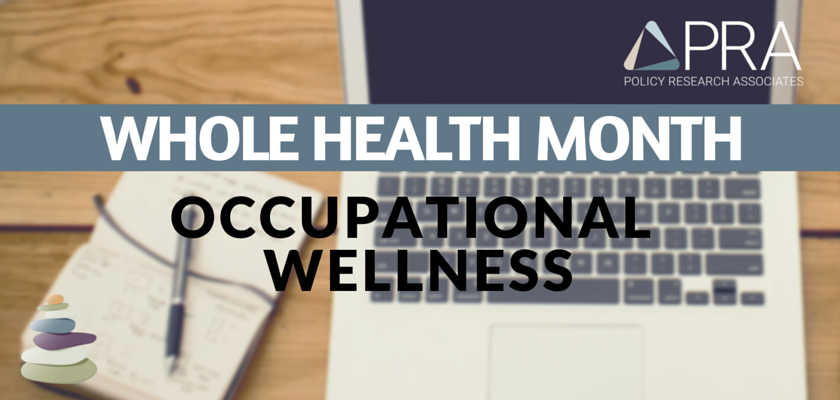Occupational wellness is defined as personal satisfaction and enrichment from one’s work (SAMHSA, 2015). I’m in a unique position because I helped write the proposal responding to SAMHSA’s RFP for the Program to Achieve Wellness. PRA received that contract, and I received a job with a program that I spent countless hours describing in the proposal. Needless to say, I’m immensely satisfied to be working on this contract, and feel enriched by the opportunity to operationalize wellness for people living all across the country, particularly those living with behavioral health challenges.
Still, despite my excitement about my work, occupational wellness also entails, I think, maintaining a work-life balance. I once took a course on work-life balance during my master’s program. And, it’s interesting that the phrase is “work-life balance” as if work was somehow separate than other parts of your life, although it’s something millions of Americans do with hundreds of millions of hours of their lives. I think it’s less about “work-life balance” and more about “balance.” And, I’m grateful to work at PRA where this balance is encouraged.
I noticed that when my occupational wellness increased–I went from occasional consulting work to full-time employment–another dimension of wellness, physical wellness, decreased. When I was consulting, I had plenty of time for physical wellness: time to plan, shop for, and cook meals; time to take long hikes and bike rides; and time to sleep without an alarm clock waking me in the morning. When work started, I got out of balance. Waking up at 7:15 a.m., driving an hour to work, working 8 hours, then driving an hour back home pretty much zapped me of my energy and drive to do anything else with my day. I forced myself to work on my dissertation after work, only to retire at 10:00 p.m. completely exhausted; and also aware of my lack of physical activity that day.
As a communication student, I thought it best to communicate rather than watch one dimension of wellness soar while another deteriorated. The culture at PRA promotes balance, and along with that comes flexible scheduling for employees. Through communication, I worked out a schedule that allows me to start some days a little later–giving me time to workout first thing in the morning, so there are no excuses after a long (and fulfilling!) day at the office. This morning workout gives me extra energy for the day, so I’m aware and alert writing my dissertation. When I’m focused on my physical wellness, I make better eating choices, too. Plus, when I come into work later in the morning, I stay at the office later and find the after hours quiet time to be quite productive. This slight transition has created more balance in my life. I wouldn’t say it created “work-life balance,” because my work is part of my life. And not just work as something synonymous with my job at PRA, but my work to promote wellness and be a resource for people seeking to attain wellness. That’s my passion. And, now I can better do that work by feeling more balance in my own life.
I’m sure there are small changes each of us could make to achieve increased wellness in various parts of our lives. Often this might involve communication – talking with a partner about the relationship, speaking with a doctor about prescription drug side effects, asking a supervisor for a flex schedule at work, or inquiring about an employee assistance program to get free help while working through a trauma or tragedy. Whatever the case may be, a little communication can go a long way with helping to get in alignment and make progress towards wellness.


